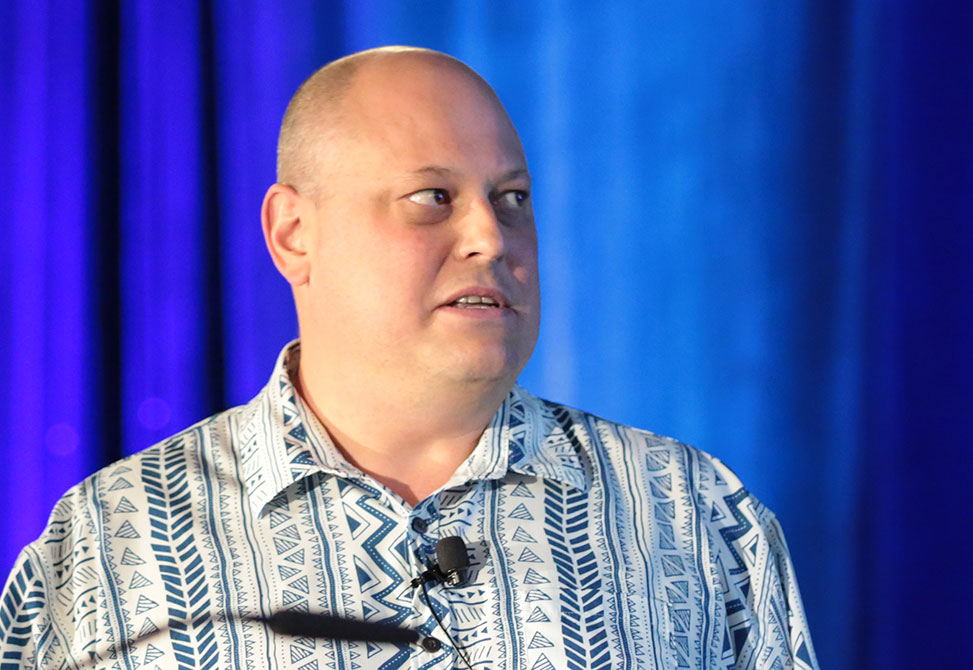Matthew Tucker
University of Nevada at Reno
Talk Title
Mapping Structure and Dynamics with Site-Specific Vibrational Probe Pairs via 2D IR Spectroscopy
Presentation Time
SESSION 15: INNOVATIVE METHODS FOR PEPTIDE STRUCTURE
Thursday, June 29, 2023, at 04:05 pm - 04:25 pm
2D IR vibrational probe pairs provide structural maps for uncovering dynamics associated with active biomolecules, providing insights into the molecular movements leading to their functionality along equilibrium and non-equilibrium pathways.1 Well-positioned probe pairs can simultaneously detect the dynamics within two different regions and measure distances in places where biological function takes place.2 Up until this point, a systematic study of a variety of 2D IR probe pairs, including labelled amides, cyano- modes, ring modes, and azido-modes have provided structural tools with many different metrics.

Now, we are moving toward transient 2DIR measurements to track non-equilibrium structural dynamics along the antimicrobial peptide pathway. Applications of these measurements to different chemical ecology problems will also be highlighted.
References
1. Matthew J. Tucker, Mohannad Abdo, Joel R. Courter, Jianxin Chen, Stephen P. Brown, Amos B. Smith III, and Robin M. Hochstrasser. Nonequilibrium Dynamics of Helix Reorganization Observed by Transient 2D IR Spectroscopy. PNAS, 2013, 110, 43, 17314-19.
2. Andrew J. Schmitz, David G. Hogle, Xin Sonia Gai, Edward E. Fenlon, Scott H. Brewer, and Matthew J. Tucker. Two-Dimensional Infrared Study of Vibrational Coupling between Azide and Nitrile Reporters in a RNA Nucleoside. J. Phys. Chem B. 2016, 120, 35, 9387–9394.
A major thrust of my research focuses on the development and application of novel, ultrafast laser spectroscopy techniques to observe the interplay of structure and dynamics in biologically relevant systems. Femtosecond, 10-15 s, laser pulses are employed to explore new linear and nonlinear infrared spectroscopic properties of molecular systems. Initiation methods, such as optical triggering, in conjunction with two-dimensional infrared, 2D IR, spectroscopy are used to acquire atomic level structural information to generate snapshots of the structural evolution in various biophysical events. Such research provides an atomistic window into drug action, protein motion and folding events, the dynamical behavior of membrane proteins, or the fast folding of RNAs, all pivotal to combat prevalent diseases and to guide drug discovery.
2D IR photon echo experiments, through a detailed analysis of spectral lineshapes, cross-peaks, and time dependent changes of the spectral signatures, allow for a direct observation of site-specific events by measuring couplings between vibrations, the appearance of energy transfer, spectral diffusion or chemical exchange events. My research develops and utilizes a variety of current and novel infrared markers as spectroscopic rulers that deliver site-specific structural changes and their time dependence. In addition, the 2D IR spectral dynamics of the vibrational markers allow detection of the properties of water local to the regions of interest. Spectral simulation brings the results of these novel experimental techniques into relationship with theory, such as molecular dynamics and quantum mechanics.
Students in my group are exposed to both hands-on experimental laser-based research as well as the application of theory to understand the spectroscopy. They have the opportunity to work with modern ultrafast laser techniques and learn how such experiments can be applied to understand intrinsic biophysical questions. Other spectroscopic techniques, such as circular dichroism, absorption, fluorescence, and vibrational spectroscopy are also utilized.






